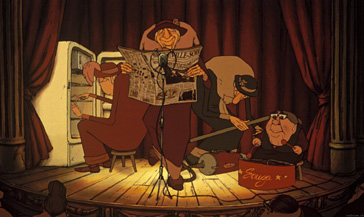Drawn That Way: The Triplets of Belleville
By Kim Hollis
May 13, 2004
A feast both for the ears and the eyes, The Triplets of Belleville is a surreal, unique movie experience that requires multiple viewings for truly complete comprehension. The film has so many tiny, fleeting little details that actually add to the overall story and effect that it becomes a pleasure to uncover something new each time I watch it.
The story itself is rather deceptive in its simplicity. A sad little orphaned boy named Champion is raised by his grandmother, Madame Souza. She is kindly and concerned, and tries everything she can to relieve his grief at the loss of his parents -- from buying him a puppy to eventually realizing his interest in bicycle racing might be just the escape he needs. She gives the lad a tricycle, setting in motion an obsession with cycling that is the foundation of their relationship.
Fast forward many years into the future, and Champion has been training at a breakneck pace and is nearly ready to compete in the world-famous Tour de France, the toughest bicycle race in the world. Madame Souza and the now grotesquely fat dog Bruno follow along as Champion undergoes the grueling competition. Suddenly, in the midst of the race, Champion and a couple of the other best competitors are kidnapped by a couple of mysterious men in black suits. Madame Souza and Bruno desperately try to catch up to the villains and rescue Champion and his compatriots, but the men are taken on a Titanic-sized ocean liner and forced across the Atlantic.
Madame Souza follows, though, and they all wind up in the metropolis of Belleville, a fictional city found in the United States. A notorious mafia group is headquartered here, but even worse are the local denizens, who are clueless and obese. Lost in a strange and unfamiliar city, Madame Souza and Bruno luckily encounter the Belleville Triplettes, three loopy old ladies who spent their youth as a glamorous, well-known harmony act. Today, the elderly sisters are a strange jazz combo, using the oddest of instruments to convey their musical message. After growing somewhat acclimated to the Triplettes' oddities, Madame Souza joins their band. At their very first live performance, they see that Champion is being held captive by the mafia godfather himself, and things go absolutely wild as a chase for the ages ensues.
And what's particularly amazing about the film is that the story is imparted with practically no dialogue.
The look of Triplets is definitely "retro", and according to director Sylvain Chomet is a throwback to the '60s style of animation that was first used in Disney's 101 Dalmatians. Considering the numerous subtle anti-Disney digs that are scattered throughout The Triplets of Belleville, it's rather interesting that the visual design is an homage to the Mouse House.
In an effective usage of contrast, the introductory portion of the film (a preface of sorts) utilizes the animation style made famous in the '30s. With caricatures of such real-life characters as Fred Astaire, Josephine Baker, Django Reinhart and Harpo Marx, this comical and creative forward establishes that the Triplettes were the biggest, most celebrated stars of their time.
Overall, the effect is definitely European, as The Triplets of Belleville always has a distinctly foreign feel to it. It's not precisely colorful or full of action, and as such, it sets itself apart from the typical "family-oriented" animated film. Additionally, the plot/action/story are so layered, complex and full of subtlety, that it takes true dedication to find the movie's rewards. It's not a film meant for children or adults with short attention spans.
Because the film has a European bent and is obviously created by a Frenchman, much has been made of the anti-American bias. There's no doubt that the film pokes fun at Americans, but those who focus on that aspect alone are missing the point. The Triplets of Belleville targets all sorts of people -- American, French, German, fat, skinny, smart, stupid, ugly, beautiful. Truly, the heroes of the film are some of the least attractive animated characters ever to be prominently featured, and yet they are lovable and sympathetic because they are human. And if Chomet makes the point that perhaps we Americans, the fattest nation on the planet, could do without a few Big Macs, he's not treading any ground that isn't also being examined by Morgan Spurlock in Super Size Me.
Really, the most noteworthy element of The Triplets of Belleville is the combination of sound effects and music. Not only will viewers of the film be humming the Academy Award-nominated "Belleville Rendez-Vous" for weeks on end, but simply listening to the rich layers of sound as they combine for a swelling, grand effect is an experience not to be missed. From the simple repair/tuning of a bike wheel to the whimsical clamor of the climactic car chase, great thought and attention were given to every single item that might contribute to the overall soundtrack. Benoit Charest deserves special commendation for his masterful score, and the sound department is nearly unrivaled in its ability to create a scene simply through the use of noise.
An unconventional film in every way imaginable, The Triplets of Belleville is a rewarding spectacle and a treasure for fans of animation of all kinds. Since we're unlikely to see such creativity in North American 2-D animated films for some time to come, it's comforting to know that such visionaries as Chomet still realize the value and opportunity the medium affords.




